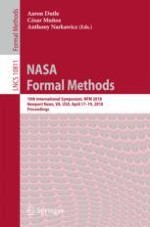2018 | Buch
NASA Formal Methods
10th International Symposium, NFM 2018, Newport News, VA, USA, April 17-19, 2018, Proceedings
herausgegeben von: Dr. Aaron Dutle, César Muñoz, Anthony Narkawicz
Verlag: Springer International Publishing
Buchreihe : Lecture Notes in Computer Science
